Daffodils are some of the most eagerly anticipated early heralds of spring here on the farm.
When our orchard slope was first cleared, the entire area looked depressingly bare.
Even with the newly planted fruit trees in place, there was a definite lack of presence in the orchard. It would take time for the trees to grow and fill in, and I’m not a terribly patient person by nature.
In a quest for some instant garden gratification, I started out by planting a few hundred daffodil bulbs. They emerged the next spring, but they seemed few and far between, so the following fall I added more. In my mind’s eye, I envisioned how the slope might look some day as the bulbs slowly naturalized, and the daffodils gained a greater presence, but I knew it would take time.
Daffodils aren’t native, obviously, but they do bring a certain cheer to the orchard before anything else blooms, and they have the advantage of being done for the season before the deciduous fruit trees leaf in too much. By the time these daffodils fade, the native poppies should be in bloom.
The last two years the daffodils have popped up in late winter, but seemed somewhat sparsely scattered across the orchard. I don’t know how 500+ bulbs can result in sparse anything, but here it’s a question of scale.
The entire orchard is surrounded by towering trees, that naturally draw the eye upward. It would be a challenge for the daffodils to stand out against such views, as their tiny scattered specks of yellow emerged along the slope in spring.
This year though I feel all that bulb planting is finally starting to pay off.
Although not yet the continuous drift of yellow I have envisioned for this area, the bulbs are clearly starting to multiply, and beginning to hold their own in the orchard.
Even the tiny Tete-a-Tetes this year have burst forth in miniature masses. Considering the scale of the planting, I’m actually quite surprised just how much impact even these diminutive blooms have in the orchard.
Ordinarily, I’m not sure I’d be brave enough to plant something bright pink next to a yellow bloom, but there’s something quite pleasing about seeing this Indian Free peach in bloom, with yellow blossoms at its feet.
Last year I started to extend the daffodils outside of the orchard fence, to bring a little cheer down to the level of the farm road. This is only their second season, but hopefully they’ll begin to fill in similarly next season.
One area that I planted the daffodils outside the fence though, is a problem. Believe it or not, Daffodils have a dark and sinister side.
There’s a small green weedy patch that leads up to the orchard gate. Most of what grows in this area seems to be gophers and voles, so last year I unloaded a few ‘spare’ daffodil bulbs on that slope. I didn’t expect much else would survive the constant churning of the soil in that area. We’ve focused on gopher removal inside the orchard, so this area has been rather neglected thus far.
I knew the gophers wouldn’t eat them, although they have managed to relocate about half of them over the past year. This weekend though, I pulled them up…all of them. Even the ones in bloom.
I wasn’t sure if I could successfully transplant blooming daffodils, or if the shock would be too much for them. It didn’t hurt to try though, or they’d be destined for compost, so I moved them to inside the orchard fence.
The question is, why would I want to move all these daffodils? As you probably know, daffodils are one of the few spring bulbs that are truly gopher, and deer proof. This is because flowers in the Amaryllidaceae family, like daffodils, contain various toxic alkaloids, including Lycorine, Galanthamine, and Narciclasine [1], that animals find unpleasant. When ingested, daffodils can cause gastrointestinal upset, including vomiting, and diarrhea. Excessive consumption of Narcissus bulbs can cause tremors and convulsions, and cardiac arrhythmias [2,3,4].

Lycorine is one of the toxic compounds that keeps our gophers and deer from devouring our daffodils (Image Source: Public Domain)
Although the bulbs are more toxic than the leaves, in light of our recent new additions to the farm, we’ve chosen to pull the daffodils from this area.
We never presume that any animal ‘knows’ to leave toxic plants alone. If that were true, toxicologists wouldn’t be as busy as they are! As such, the daffodils have now been rehomed inside the orchard where the goats can’t reach them.
As this weedy patch gets plenty of sun, we’ve had a change of plan. The revised plan for this area is to turn our mini-meadow into a safe place for the goats to occasionally romp around on a warm summer’s afternoon, without worrying about whether or not they’ll browse on potentially poisonous plants.
With a shift in the weather this week, to something that more closely resembles winter than spring, we’re expecting some significant rainfall over the next few days. We’ve already had more than 2 inches of rain since midnight. This slope was desert dry over the weekend, so much so the soil was beginning to crack, so the rain is very welcome.
With the daffodils now gone, the meadow area was cut, and today, between the rain showers, I’m hoping to dash out to sow some of this goat-friendly dairy pasture mix in the meadow instead.
It won’t be as pretty, but the goats will enjoy that area once it’s replanted. They’ll just have to be content to admire the daffodils from afar.
——————–
[1] Vigneau CH, Tsao J, Chamaillard C, and Galzot J. Accidental Absorption of Daffodils (Narcissus jonquilla): Two Common Intoxicants. Vet Hum Toxicol. 1982;24:133–135.
[2] Aganga A, Nsinamwa M., Oteng K., and Maule B. Poisonous Plants in Gardens and Grazing Lands. Online Journal of Animal Feed and Research. 2011; 1(2): 52-59.
[3] Saxon-Buri, S. Daffodil Toxicosis in an Adult Cat. The Canadian Veterinary Journal. 2004; 45(3): 248-250.
[4] Animal Poison Control Center: Daffodil



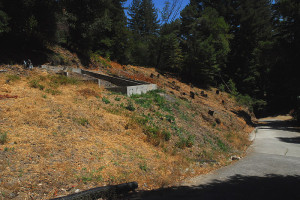
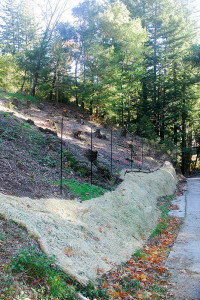


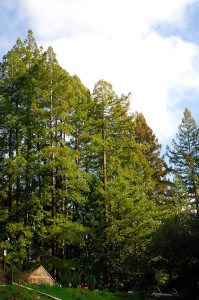

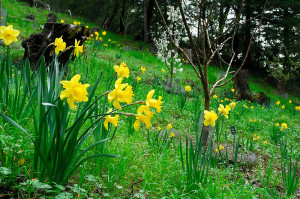
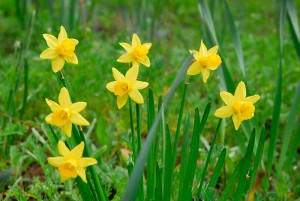

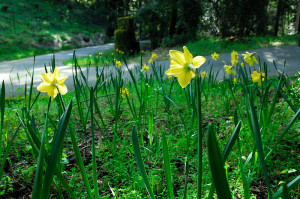
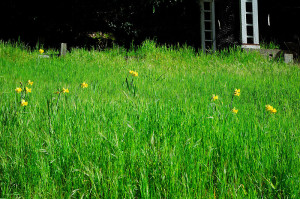
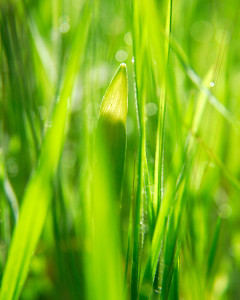

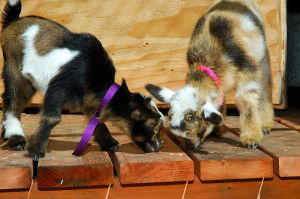
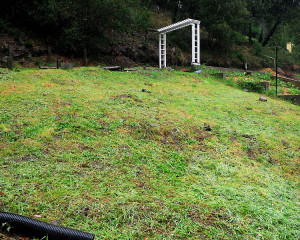

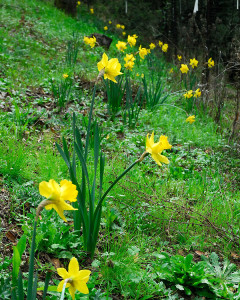







Oh, I see now,…it’s all about the goats! hahaha That’s a lot of work to transplant daffodils, but I could see me doing that, too!
My eyebrows flew up when you said you were transplanting ‘blooming’ daffodils. I have some I’d like to move,…too much in the shade,…so I’ll be watching for an update.
What grasses are in the dairy mix?
So far the transplants are doing well. They’re a bit droopy today because of the rain, but that may also help them settle in too. I’ll let you know how they do though.
The dairy pasture mix is predominantly orchard grass, and annual and perennial rye grass. There’s also some White Ladino Clover that will do better in spring, and some Palestine Strawberry Clover that should persist through summer better, as it’s more drought tolerant. It’s not quite all about the goats…I suspect the bees will enjoy the clover too 😉
btw, each of your photos here are lovely, I clicked on each one to see them bigger! 🙂
I hope you didn’t look too closely at the barren slope photo. Although I sometimes pull that out to remind myself that we actually are making progress in this part of the garden!
Clare,
Not sure the goats would have eaten the daffodils, but better to be safe I guess. We planted lots of daffodils 2 and 3 years ago, many are just fading away, so sad.
Making a nuk from my hive on Thursday, have a master beekeeper come over to help. There is at least 5-6 swarm cells started.
There have been reports of narcissus toxicity in goats, although I think it’s relatively rare. Seeing what these two already try to put in their mouths though, it’s one less thing to worry about.
Good luck with your nuc. As you already have swarm cells, that should decrease the time it takes to get a laying Queen in the nuc. We so need to get Lavender split, we just haven’t had time. I’m afraid as soon as this rain lets up, she’ll swarm!
Mmm, lovin the look of the daffs scattered through the orchard. I actually love Tete a Tete, t is the one most commony forced, so I got a lot of ‘free’ ones when I was working. The seem to increase very well, and don’t fall over like the large ones.
This is the first time I’ve ever grown Tete-a-Tete. They actually remind me of the wild tiny daffodils we’d see growing in the Yorkshire countryside in spring. I love that they don’t drop to the ground with the first ounce of rain, and I hope many more of them will grow in the coming seasons!
What a charming finish to your post! As for the first section, I bet every gardener identifies with “but I planted so much _______, why isn’t it making the impact I had in my mind’s eye?”. Soon your orchard will be one of THOSE places on the annual daffodil tours….
Well, I know I can’t have the look of daffodil drifts that have been growing for 30 years in just two, but I am pleased with how they’re growing so far. I feel a little less like I need to dash out and plant 500 more 😛
Before I finished reading your post, I was about to ask “Can one ever have too many daffodils?” I guess your answer would be “yes.” I didn’t realize that they are toxic; perhaps that’s why the cotton tails here don’t eat them–they know better. Little goats, probably not. The little goats are really cute.
Not so much too many (I don’t actually think that’s possible), but I did have a few in place that wasn’t ideal. The advantage of moving them now though is I can see them. Moving them when they’re dormant would have been almost impossible…especially with the gophers moving them around 😉
Goats eat tin cans* so what could daffodils possibly do? 🙂
*I get my goat info from old cartoons
I saw those old cartoons too, along with goats stealing laundry off the line. They actually are much more picky about what they eat, but sometimes their curiosity will still get the better of them. Instead of daffodils, I’d like to steer them toward the mounds of wild blackberries running amok here! 🙂
Beautiful! I am not a patient person either, so planting bulbs is out of question for me. So, if I have to plant that many bulbs, I’d probably hire someone to do it :). I am that lazy!
I must admit, I was running out steam planting those bulbs. I tried to stay motivated by imagining how’d they’d look some day, but planting bulbs is not the most exciting chore in the garden…but the effort is always well worth it when they bloom!
I couldn’t figure out why you were moving them and then ahhhhh…the goats…anything for those darlings!!
Exactly. We want the goats to be happy and healthy. If they’re happy, I’m happy 🙂
The mass planting was so pretty but I fully understand you moving them for the goats. The goats grazing their will be just a pretty and the view will last all year too!
The daffodils inside the orchard weren’t touched at least, and those had been in place a little longer. The ones we moved actually helped to fill in a few bare spots in the orchard, and I’m sure the clovers will be pretty in bloom.
What a job to move those daffodils, but I certainly understand. And I know your goats are appreciative, even if they don’t tell you so! I am so impressed with 500 daffodil bulbs – it will be a mass of beauty in another year or two!
I what surprised me most was how heavy the bucket kept getting with the daffodils. We’d dig some up, put them in the bucket, carry them across the orchard and replant them. But it was a lot of very heavy buckets! A good workout though 😛
Clare,
The nuk will become another hive, thinking two will be all I want in our back yard. Planning on at least 2 more at the farmer about a 1/2 mile from here. I made 2 swarm traps, have one mounted in a tree 12 ft up about 75 ft from our hive. Going to get lures or lemon grass oil to put in them in the morning.
We have one bait hive out, just in case Lavender swarms before we get her split. Good luck with your nuc, I hope they make a nice healthy, robust, and friendly Queen!
I’ve moved daffodils before – when blooming and just after blooming. The majority of them did just fine. I’ll bet yours do too, as long as they get some rain while their roots are getting re-established.
Well, they’re definitely getting the rain today. Last I checked we were up to 2.5 inches, with more on the way over the next few days. So long as they don’t slide down the slope, they should settle in nicely 🙂
I just LOVE LOVE that meadow look with the daffodils and the blossoms on the fruit trees. But the pasture is more practical for the goaties and daffodils are still there. Just lovely!!!
Unfortunately, as soon as this rain lets up I’ll have to cut most of the ‘meadow’ in the orchard (and try not to behead too many daffs in the process). I can’t believe how quickly everything is growing…including the blasted voles. Need to knock down that ground cover before their populations explode again 🙁
That must have been a pain but worth it for the safety of your new baby goats. For future daffodil planting projects consider planting them in groups of 10-15 bulb clumps rather than singles dotted around. It should help make it look less sparse and as long as you spread the clumps out a bit it should still fill in nicely when they naturalize.
Believe it or not, the daffodils were planted in groups of 6-15 (depending on how many trees roots/rocks/mudstone outcroppings were in the way). That’s the problem with the scale of this slope, even 15 daffs don’t look like much! 😛
I love the daffodil field – would love to see a photo of the daffs all in bloom and how it looks from far.
If I pull the camera back too much, they become rather insignificant dots of yellow, at least in a picture. They look better in person, but until they fill in more, they won’t make much of impact in a wide-angle landscape shot 😉
The daffodils were pretty, but that Indian Free peach tree blossom is stunning. I bet the fruit trees put on quite a show!
I should post a photograph of just those peach blossoms. They’re really quite impressive, and over an inch across! For such a young tree, I’ve been really impressed with the flowers this year. I just hope they’re not all getting knocked off with this rain! We’ll need to be sure we don’t allow this tiny tree to set too much fruit this year, but I’m anxious to try one of these white peaches 🙂
Wow, Clare, you have so much going at your beautiful farm: chickens, turkeys, goats, orchard, veggie garden, native plant garden, 500 daffodils. Utterly amazing. Do you sleep?
Well I can understand you moving them as you just can’t take the risk. I’m sure that I’ve moved flowering daffodils in the past and I think that they coped with the shock ok. It’s lovely seeing the flowers finally start to naturalize in the orchard against that framework of tree blossom…. it just shouts ‘spring’ to me.
Holy Cats and Kittens! What a lot of work.
Am I weird because I love how pink looks with yellow? Every time I see or hear someone saying it is a bad thing, I am left scratching my head.
Your goats are so so so so so so cute. I would dig up all my bulbs for them, too!